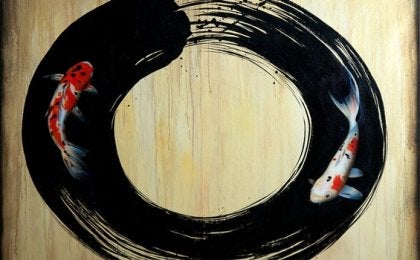The Enso or Zen circle, symbolizes the fullness of the simple, represents the infinite content in the perfection of harmony, few spiritual symbols are so magnetic to the viewer and, at the same time, powerful to those who paint them. those who have a weight-free mind and enlightened by inner balance are able to draw a perfect circle, but never closed.
Buddhist teachers often say that Enso cannot be explained, in fact, there is only one way to understand it in all its nuances, in all its essence: to experience it.
- This symbol is not just a circle.
- Nor is it an art form.
- We know that it is increasingly common to use this minimalist expression of the Zen school as a tattoo.
- However.
- Its involvement goes much further.
Enso is a state of mind. It is the perfect point of harmony where the body and mind are free to be able to pour out their inner perfection through a gesture, a movement.
Its function is to express a personal state in which everything is complete, where everything and nothing exists at the present moment and can be contained in the form of a circle that remains open, this is where an opening is left to empty this small part that is not always open to infinity.
Creating a Japanese Enso requires practice and mental calm, because an Enso is painted with a continuous stroke, a single stroke and with a single opportunity to finish it, you can’t go back and fix it.
Circles have always been of magical, symbolic and spiritual importance. Carl Jung himself spent much of his life fascinated by this form and, in particular, by the concept of mandalas.
So much so that in his free time or when he needed to keep his problems at bay, he drew circles. According to him, they symbolized the formation and transformation of the mind itself. According to this famous Swiss psychiatrist, through these forms we find calm, but also the impulse to go further.
As for Zen Buddhism, Enso’s circle recalls the perfect moment when the mind is free to leave the body, so that the spirit rises, so only a complete person mentally and spiritually is able to draw a true Enso.
It is, so to speak, a reflection of his enlightenment expressed through a drawing, the firm and confident pulse of an artist capable of evoking his inner perfection.
If you are wondering about the origin of this symbol, we must go back in time to the 28th century BC. in China, when this idea appeared, concept that was then imported into Japan by Buddhist monks.
Shinjinmei, an oriental poem containing the essence of Zen Buddhism, describes Enso as a vast space where nothing is missing or left, and explains that the practice of drawing these circles was born when a monk asked his teacher to explain, in words, The master replied that something like this cannot be described by words or letters, then took a brush and rice paper and drew the circle.
The shape of the circle is rooted in almost all cultures, however, this symbol goes far beyond its line. Indeed, a myriad of traditions evokes in it the perfect representation of the world itself, of the movement, and also of the epicenter where everything is united and concentrated; symbolizes the snake that bites its tail in an infinite cycle.
It is the full moon that attracts the tides in its contact with nature, it is the empty cup of tea where you can read the future and even the wheel of dharma containing the wisdom of Buddhism. Enso is essentially the universe itself in motion.
“Enso does not depend on language, so you must abandon your intellect and communicate more deeply. It’s simple, because more than a circle, it’s a very demanding experience because there’s no explanation. We have to live it. An Enso is made with a decision. , once and without correction. But it’s not a creative act. Drawing a Zen circle is a creative experience without using creativity.
To draw an Enso you have to start from an idea: fukinsei, the denial of perfection, it is simply a matter of capturing the present moment through mindfulness, it is necessary to free the mind of thoughts, free it of all concern in order to experience this authentic contact with himself, where the trace of the circle is registered in a single movement.
We need to move away from the claim that a “perfect circle” will emerge. Since we don’t seek perfection, you don’t need to think about our skills, our efforts, or our results. You have to let it flow, let it go.
Zen art is an external expression of the inner state, so to draw or paint an authentic Enso you need continuous work to achieve calm and balance, only when we are really prepared will we form this imperfect circle that will perfectly represent the present moment. .

